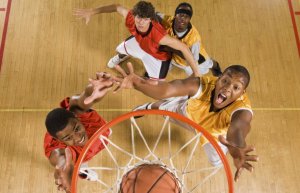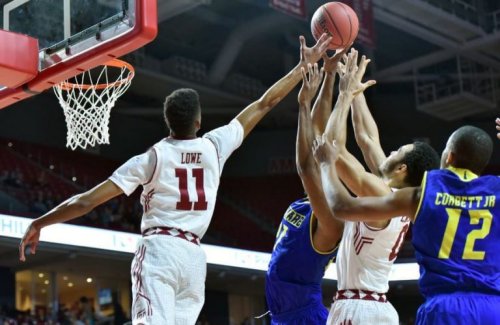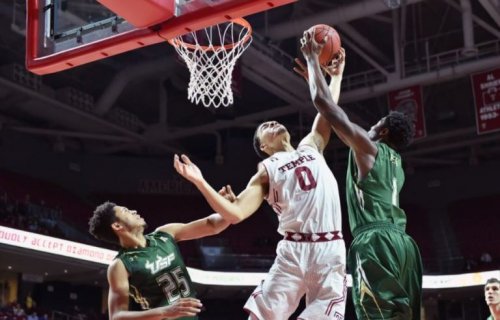Improve your Rebounding Skills in Basketball

Even if it’s not as relevant since the 3-pointer gained popularity in basketball, it’s fundamental for a team to focus on rebounding in modern basketball. This is because of the benefits it has both in offensive moves (to easily score more points) and defense moves (avoiding strong offensive players to get closer to the basket) if done correctly.
Since it’s not as popular anymore, we want to explain it, focusing on how to rebound and some tips and exercises to get better at it.
How to rebound?
First blocking, then catching
Before a rebound, it’s necessary to shoot to the basket (either as an offensive or a defensive move).

The moment you see the player throw the ball, no matter if they do it from the three-point line or if it’s a two-point shot, you must follow these simple steps to avoid your opponent catching the ball:
- You must keep an eye on the offensive player you need to block. If you know where your direct opponent is, you’ll prevent them coming from your back to retrieve the ball. If every player in the team does this, the opponent team won’t have a second chance to attack.
- Once you know where your direct opponent is, proceed to rebound; with your back to the offensive player, use your body to avoid them getting past you. It’s important that you don’t use your hands or arms to avoid any foul.
Given how simple this whole process looks, rebounding is relatively easy. However, in most matches players make many mistakes when using this technique, which translates into easy points for the opposing team.
Some examples
Players who are experts at rebounding, such as Felipe Reyes for instance, follow these steps to the letter every time another player shoots to the basket.
That, and their goal to catch the ball makes him and others like him, the leaders in the rebound “field”. Sometimes this technique can make the player feel as if the ball always “falls right into their hands”.

How to get better at rebounding?
A basic exercise
In order to start this exercise, the coach must put players in couples, so that one plays as a defensive and the other as the offensive player.
The coach, or a player (in case there’s more than 10 of them), makes a shot to the basket; the defensive players must let the ball bounce once before the offensive players catch it, while the latter must focus on rebounding.
To motivate the players to do the exercise correctly, the coach can set up prizes or punishments (such as push-ups, crunches or running around the field).
This simple exercise is ideal to improve your rebounding skills; it’s specially useful for young players.
A more complicated rebounding exercise
Players make a three-row formation, so that player number 1 is in the point guard position, and players number 2 and 3 are the small forwards.
Player number 1 passes the ball to the player on his right (number 2) who starts dribbling to the end line, always out of the three-point line; as this happens, players 1 and 3 interchange positions.
Once player 1 gets to the corner, player 2 passes the ball to player 3, who’s in the triple-threat position after changing positions with player 1.
Then, once player 3 receives the ball, they throw it back to player 1, who makes a 3-pointer.
After the shot, player 3 will act as a defensive player, and 2 as an offensive player. If the former rebounds -or makes a basket- three new players can come into the field. But, if player 2 rebounds, then there will be a one versus one with player number 3.
Rotation must always be to the right: player 1 goes to the position of player number 2, who goes to player 3’s position, and this last one goes to player 1’s position.
These are only two examples of the many exercises you can do to improve your rebound skills.
Even if it’s not as relevant since the 3-pointer gained popularity in basketball, it’s fundamental for a team to focus on rebounding in modern basketball. This is because of the benefits it has both in offensive moves (to easily score more points) and defense moves (avoiding strong offensive players to get closer to the basket) if done correctly.
Since it’s not as popular anymore, we want to explain it, focusing on how to rebound and some tips and exercises to get better at it.
How to rebound?
First blocking, then catching
Before a rebound, it’s necessary to shoot to the basket (either as an offensive or a defensive move).

The moment you see the player throw the ball, no matter if they do it from the three-point line or if it’s a two-point shot, you must follow these simple steps to avoid your opponent catching the ball:
- You must keep an eye on the offensive player you need to block. If you know where your direct opponent is, you’ll prevent them coming from your back to retrieve the ball. If every player in the team does this, the opponent team won’t have a second chance to attack.
- Once you know where your direct opponent is, proceed to rebound; with your back to the offensive player, use your body to avoid them getting past you. It’s important that you don’t use your hands or arms to avoid any foul.
Given how simple this whole process looks, rebounding is relatively easy. However, in most matches players make many mistakes when using this technique, which translates into easy points for the opposing team.
Some examples
Players who are experts at rebounding, such as Felipe Reyes for instance, follow these steps to the letter every time another player shoots to the basket.
That, and their goal to catch the ball makes him and others like him, the leaders in the rebound “field”. Sometimes this technique can make the player feel as if the ball always “falls right into their hands”.

How to get better at rebounding?
A basic exercise
In order to start this exercise, the coach must put players in couples, so that one plays as a defensive and the other as the offensive player.
The coach, or a player (in case there’s more than 10 of them), makes a shot to the basket; the defensive players must let the ball bounce once before the offensive players catch it, while the latter must focus on rebounding.
To motivate the players to do the exercise correctly, the coach can set up prizes or punishments (such as push-ups, crunches or running around the field).
This simple exercise is ideal to improve your rebounding skills; it’s specially useful for young players.
A more complicated rebounding exercise
Players make a three-row formation, so that player number 1 is in the point guard position, and players number 2 and 3 are the small forwards.
Player number 1 passes the ball to the player on his right (number 2) who starts dribbling to the end line, always out of the three-point line; as this happens, players 1 and 3 interchange positions.
Once player 1 gets to the corner, player 2 passes the ball to player 3, who’s in the triple-threat position after changing positions with player 1.
Then, once player 3 receives the ball, they throw it back to player 1, who makes a 3-pointer.
After the shot, player 3 will act as a defensive player, and 2 as an offensive player. If the former rebounds -or makes a basket- three new players can come into the field. But, if player 2 rebounds, then there will be a one versus one with player number 3.
Rotation must always be to the right: player 1 goes to the position of player number 2, who goes to player 3’s position, and this last one goes to player 1’s position.
These are only two examples of the many exercises you can do to improve your rebound skills.
This text is provided for informational purposes only and does not replace consultation with a professional. If in doubt, consult your specialist.








